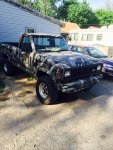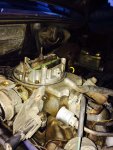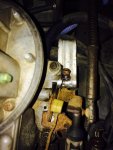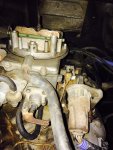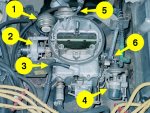Emeralddream
Member
- Joined
- May 30, 2015
- Messages
- 7
- Vehicle Year
- 1985
- Transmission
- Manual
So Recently purchased this beauty and have fixed a few minor issues (replace powersteering pitman arm seal, new steering wheel, 2 inch pitman arm drop, and wheel spindle and bearings replaced. Not sure how the attached pictures will show up but the first one is my truck obviously and the second, third, forth are the carburetor.
I guess I'll start off by saying I am planning on putting a v8 in at some time or another I just have to get the funds. However, I would like to drive the truck on commute and take it hunting in between time.
I have read a lot about the problems of the rangers in the highly extensive tech articles on this site (love those articles keep up good work! It helped me with my from tire wear problem because of the stock pitman arm was still on after a lift was installed). I noticed that a common problem of the v6 2.8 is that it will stutter on take off almost like it is not getting enough fuel. The two solutions were to change accelerator pump (i took the one off of the carb and it looked brand no so not the problem) or the fuel bowl is low. I am not sure how to go about fixing the fuel bowl or even checking to see if it is the problem.
The real issue is it is stumbling on take off I have not taken the carb off to install the carb kit contents that I purchased on the carb yet but I am wondering if I should just get a new one for 250 since someone has had their hands in this I'm not sure if i should just get a new one or not... I also had a question about the ISC motor... It seems to be spazzing out at times on startup and making it idle very high regardless if the engine is warm or not. Sorry for the essay, but one more question is what in the world the foreign bracket is mounted on the accelerator spring in picture 3. I'm just lost atm and looking for comfort lol... I was also looking a duraspark 2 exchange and tfi conversion but the tfi seems like a lot of work pulling out the engine and all...
I have not taken the carb off to install the carb kit contents that I purchased on the carb yet but I am wondering if I should just get a new one for 250 since someone has had their hands in this I'm not sure if i should just get a new one or not... I also had a question about the ISC motor... It seems to be spazzing out at times on startup and making it idle very high regardless if the engine is warm or not. Sorry for the essay, but one more question is what in the world the foreign bracket is mounted on the accelerator spring in picture 3. I'm just lost atm and looking for comfort lol... I was also looking a duraspark 2 exchange and tfi conversion but the tfi seems like a lot of work pulling out the engine and all...
I guess I'll start off by saying I am planning on putting a v8 in at some time or another I just have to get the funds. However, I would like to drive the truck on commute and take it hunting in between time.
I have read a lot about the problems of the rangers in the highly extensive tech articles on this site (love those articles keep up good work! It helped me with my from tire wear problem because of the stock pitman arm was still on after a lift was installed). I noticed that a common problem of the v6 2.8 is that it will stutter on take off almost like it is not getting enough fuel. The two solutions were to change accelerator pump (i took the one off of the carb and it looked brand no so not the problem) or the fuel bowl is low. I am not sure how to go about fixing the fuel bowl or even checking to see if it is the problem.
The real issue is it is stumbling on take off
 I have not taken the carb off to install the carb kit contents that I purchased on the carb yet but I am wondering if I should just get a new one for 250 since someone has had their hands in this I'm not sure if i should just get a new one or not... I also had a question about the ISC motor... It seems to be spazzing out at times on startup and making it idle very high regardless if the engine is warm or not. Sorry for the essay, but one more question is what in the world the foreign bracket is mounted on the accelerator spring in picture 3. I'm just lost atm and looking for comfort lol... I was also looking a duraspark 2 exchange and tfi conversion but the tfi seems like a lot of work pulling out the engine and all...
I have not taken the carb off to install the carb kit contents that I purchased on the carb yet but I am wondering if I should just get a new one for 250 since someone has had their hands in this I'm not sure if i should just get a new one or not... I also had a question about the ISC motor... It seems to be spazzing out at times on startup and making it idle very high regardless if the engine is warm or not. Sorry for the essay, but one more question is what in the world the foreign bracket is mounted on the accelerator spring in picture 3. I'm just lost atm and looking for comfort lol... I was also looking a duraspark 2 exchange and tfi conversion but the tfi seems like a lot of work pulling out the engine and all...
Attachments
Last edited:

